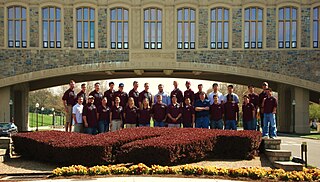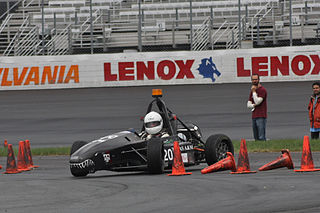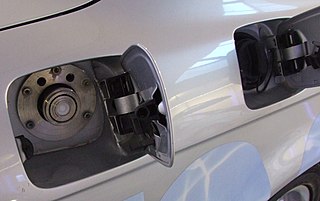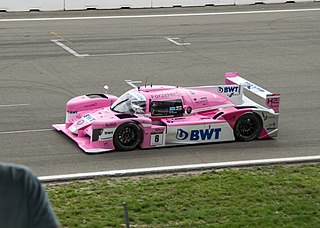
A hydrogen vehicle is a vehicle that uses hydrogen fuel for motive power. Hydrogen vehicles include road vehicles, rail vehicles and hydrogen-fueled space rockets, as well as hydrogen-powered ships and aircraft. Motive power is generated by converting the chemical energy of hydrogen to mechanical energy, either by reacting hydrogen with oxygen in a fuel cell to power electric motors or, less commonly, by hydrogen internal combustion.

A fuel cell vehicle (FCV) or fuel cell electric vehicle (FCEV) is an electric vehicle that uses a fuel cell, sometimes in combination with a small battery or supercapacitor, to power its onboard electric motor. Fuel cells in vehicles generate electricity generally using oxygen from the air and compressed hydrogen. Most fuel cell vehicles are classified as zero-emissions vehicles that emit only water and heat. As compared with internal combustion vehicles, hydrogen vehicles centralize pollutants at the site of the hydrogen production, where hydrogen is typically derived from reformed natural gas. Transporting and storing hydrogen may also create pollutants. Fuel cells have been used in various kinds of vehicles including forklifts, especially in indoor applications where their clean emissions are important to air quality, and in space applications. Fuel cells are being developed and tested in trucks, buses, boats, ships, motorcycles and bicycles, among other kinds of vehicles.

The Honda Clarity is a nameplate used by Honda on alternative fuel vehicles. It was initially used only on hydrogen fuel-cell electric vehicles such as the 2008 Honda FCX Clarity, but in 2017 the nameplate was expanded to include the battery-electric Honda Clarity Electric and the plug-in hybrid electric Honda Clarity Plug-in Hybrid, in addition to the next generation Honda Clarity Fuel Cell. Clarity production ended in August 2021 with US leases for the fuel cell variant continuing through to 2022.

Challenge X: Crossover to Sustainable Mobility, known more commonly as Challenge X, was a four-year competition series amongst engineering students from across North America. Its purpose was to advance vehicle technology towards a goal of sustainable mobility.

The Hokie Electric Vehicle Team of Virginia Tech, better known as HEVT, is a nationally recognized undergraduate student design team in the Department of Mechanical Engineering at Virginia Tech. HEVT was formed in 1994 to compete in the 1995 Hybrid Electric Vehicle (HEV) Challenge, one of the many competitions organized by the Argonne National Laboratory through the United States Department of Energy. HEVT has been involved in the Department of Energy Advanced Vehicle Technology Competitions (AVTCs) ever since. HEVT attributes a significant amount of its success to their Advisor, Professor Doug Nelson in Mechanical Engineering. Dr. Nelson has received the Outstanding Faculty Advisor award at competition 3 times. He has greatly aided the education of students at Virginia Tech and helped the team succeed at competition The overall highlights of past competitions are as follows:

The restyled North American second generation Ford Focus was sold by Ford as either a two-door coupe and 4-door sedan — the hatchbacks and wagon were discontinued.

Eco-Runner Team Delft is a Delft University of Technology student team, aiming to promote a sustainable future by building the world's most efficient hydrogen-powered car. At the end of the year, the team participates in the Shell Eco-marathon competition in order to assess the efficiency of the vehicle. Eco-Runner Team Delft won the competition in 2015 and 2022. In the competition there are two vehicle classes: Prototype and UrbanConcept. For years Eco-Runner Team Delft participated in the Shell Eco-marathon Prototype class competition where the goal is to cover a certain distance with the least amount of hydrogen. In the year 2019–2020, the team has decided to compete in a different competition; the Urban Concept class. This challenge offers the team the opportunity to design and build an efficient hydrogen-powered vehicle that is closer in appearance to modern city cars.

Formula Hybrid is a design and engineering challenge for undergraduate and graduate college and university students. Started at the Thayer School of Engineering at Dartmouth College, and sponsored by the Society of Automotive Engineers, the competition is a spinoff of the Formula SAE competition based on hybrid vehicle technology. They must design, build, and compete an open-wheel, single-seat race car. This car must conform to a formula which emphasizes drive train innovation and fuel efficiency in a high-performance application.
Formula Zero was an organization based out of Amsterdam in the Netherlands and was founded in 2003. Its vision was to demonstrate that zero emissions technology can be both fun and sustainable at the same time by racing to get people interested in hydrogen fuel cell technology. In 2005, Formula Zero began construction of the Mark 2, the world's first fully functional fuel-cell powered go-kart using ultracapacitors for energy storage. On October 26, 2006, the Mark 2 set an official FIA record of 1/8 of a mile in 11.869 seconds. The Mark 2 was featured on the Discovery Channel as a part of the FutureCar television series. Formula Zero set a new FIA record with the Mark 2 in September 2007.

A battery electric vehicle (BEV), pure electric vehicle, only-electric vehicle, fully electric vehicle or all-electric vehicle is a type of electric vehicle (EV) that exclusively uses chemical energy stored in rechargeable battery packs, with no secondary source of propulsion. BEVs use electric motors and motor controllers instead of internal combustion engines (ICEs) for propulsion. They derive all power from battery packs and thus have no internal combustion engine, fuel cell, or fuel tank. BEVs include – but are not limited to – motorcycles, bicycles, scooters, skateboards, railcars, watercraft, forklifts, buses, trucks, and cars.

A hydrogen internal combustion engine vehicle (HICEV) is a type of hydrogen vehicle using an internal combustion engine. Hydrogen internal combustion engine vehicles are different from hydrogen fuel cell vehicles. Instead, the hydrogen internal combustion engine is simply a modified version of the traditional gasoline-powered internal combustion engine. The absence of carbon means that no CO2 is produced, which eliminates the main greenhouse gas emission of a conventional petroleum engine.

Forze Hydrogen Racing is a hydrogen electric vehicle racing team. It is run by students and was founded at the Delft University of Technology in 2007 by Edgar van Os and has built 8 hydrogen fuel cell racing vehicles. The team's offices and workshops are located at the Schiehal in Delft. In 2007, the team began designing and building go-karts with a hydrogen-electric drivetrain. With these vehicles they participated in the Formula Zero competition, hence the name ForZe. After five years the first full-size hydrogen race car was built, the Forze VI. Another three years later the project of the Forze VII began. This became the first hydrogen-electric racecar to ever participate in an official race against fossil-fueled vehicles. The latest iteration, the Forze VIII, was the first hydrogen-electric race car to ever beat petrol powered cars, and came in 2nd place at the Gamma Racing Days in Assen in 2019. Over the coming years the team wants to develop its cars in such a way that they can compete in a Le Mans Prototype endurance series.

The Mercedes-Benz BlueZERO concept is Mercedes' attempt at the alternative fuel vehicle movement. The BlueZERO is a flexible concept that has the ability to accommodate the three different types of future alternative fuels: electric, hybrid, and hydrogen fueled. It was first introduced at the 2009 Detroit Auto Show which took place January 11–25. It features a single vehicle architecture that accommodates three models with different electric power-train configurations, each of which are fully developed and ready for testing. The Mercedes-Benz BlueZERO electric drive system gives each model the same performance specifications for acceleration and top speed. The Mercedes-Benz BlueZERO electric drive modular design accelerates from 0 to 100 km/h (62.5 mph) in under 11 seconds, and the top speed is electronically governed to 150 km/h (93 mph) in the interests of optimal range and energy efficiency. Peak torque is 320 N⋅m (236 lb⋅ft) and as with all EVs, maximum torque is available from zero rpm.
Toyota concept vehicles are transportation devices manufactured or designed by automobile company Toyota from 2000 to 2009. As their name suggests, these vehicles were concepts, and, as such, many were never released to dealerships. Many were developed in conjunction with other corporations such as Sony or Subaru.
The Mizzou Hydrogen Car Team designs, builds and competes with an Urban Concept hydrogen fuel cell vehicle run by students at the University of Missouri in Columbia, Missouri. They recently competed with their vehicle named "Tigergen III" in the 2013 Shell Eco-Marathon. At the competition they achieved 8.8 mi/kWh which placed them 3rd in the UrbanConcept Hydrogen category. The team also won an off-track award for "Best Team Spirit"

Alset Global GmbH is an Austrian technology and engineering company based in Graz specializes in hydrogen-based clean mobility products. Alset Global is known for developing a Hybrid Hydrogen capable of running an internal combustion engine on either pure petrol, pure hydrogen or a combination of both. technology offers a new sustainable and clean alternative to the automotive industry. The technology has been developed to create an alternative technology to meet new emission target levels. Alset Global also specializes in hydrogen system integration, hydrogen gas storage, and software development.

The Toyota Mirai is a mid-size hydrogen fuel cell vehicle (FCV) manufactured by Toyota, and is the first FCV to be mass-produced and sold commercially. The Mirai was unveiled at the November 2014 Los Angeles Auto Show. As of November 2022, global sales totaled 21,475 units; the top-selling markets were the U.S. with 11,368 units, Japan with 7,435 and the rest of the world with 2,622.

The Hyundai ix35 FCEV or Tucson FCEV is a hydrogen fuel cell electric vehicle developed by Hyundai. The model is a left-hand drive only conversion to the SUV platform it is based on and was the first of its type to be mass-produced and sold commercially in the world. Different versions are known, the previous version was based on the Hyundai Tucson FCEV, and the upcoming model is based on the current ix35 FCEV. The first generation was introduced in 2001, with the Hyundai Santa Fe FCEV, and had a range of 100 miles (160 km), with a top speed of 78 mph (126 km/h).

The Jeep Treo was an electric concept car produced by Chrysler under their Jeep brand in the early twenty first century. Launched at the 2003 Tokyo Motor Show, it was envisaged for production in 2008, but the single prototype remained a one-off. Designed for the Asian young urban driver, the car was fitted with three seats and had the provision to carry mountain bikes as an integral part of the near-teardrop shaped design. Although the prototype was designed to be powered by a hydrogen fuel cell, in its production form the car was to be given hybrid petrol-electric drive.































